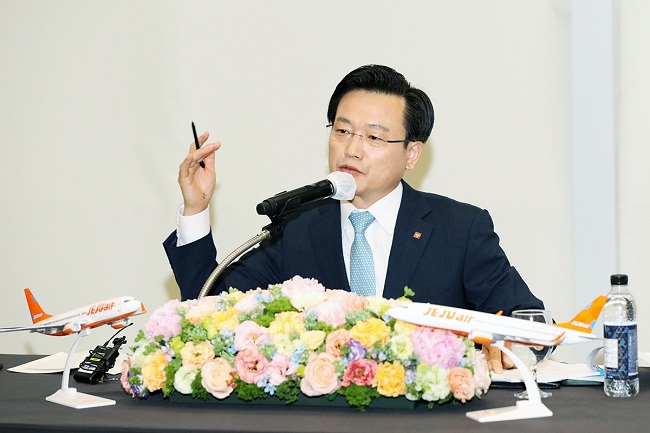
Jeju Air CEO Kim E-bae answers questions from reporters during a Q&A session at Mayfield Hotel in western Seoul on June 7, 2022, in this photo provided by the budget carrier.
SEOUL, June 7 (Korea Bizwire) — Jeju Air Co., South Korea’s biggest low-cost carrier, said Tuesday it is targeting to turn around next year as eased virus restrictions unleash pent-up travel demand.
Jeju Air posted net losses for three consecutive years through 2021 due to the impact of the COVID-19 pandemic on the airline industry.
Jeju Air’s net losses slightly narrowed to 273 billion won (US$217 million) in 2021 from 307 billion won a year earlier. In 2019, it logged a net loss of 33 billion won, shifting from a net profit of 71 billion won a year ago.
“It will be hard to make a turnaround this year due to uncertainties in major (destination) markets. But we aim for a turnaround next year as more Asian countries are expected to reopen their borders to tourists,” Jeju Air CEO Kim E-bae said in a press conference.
Japan plans to receive tour groups of international travelers starting June 10 and the number of arrivals permitted a day has been increased from 10,000 to 20,000.
The CEO expected China, Hong Kong and Taiwan to reopen their borders at least at the end of this year amid the pandemic’s slowdown, giving a boost to the bottom lines of airlines.
The addition of a new route and planes will also help put Jeju Air back on track though it depends on how much travel demand will recover later this year, the executive said.

This file photo, provided by Jeju Air, shows a Jeju Air plane taking off at an airport in South Korea.
Jeju Air will be able to begin offering four flights a week on the Incheon-Ulaanbaatar route next month though the flight schedules are only available during the June-September peak season each year, he said.
The new route became available after South Korea and Mongolia agreed in August to double the permitted number of passengers on the route to 5,000 per week from 2,500 during the four-month period starting this year.
In Korea, two full-service carriers — Korean Air Lines Co. and Asiana Airlines Inc. — have exclusively provided flights on the Mongolia route. Korean Air and Asiana have rights to offer six and three flights a week, respectively, on the route.
The bilateral aviation talks allowed one additional flight each to Korean Air and Asiana, four new flights to Jeju and three new to another budget carrier, T’way Air, during the high season.
On existing routes, Jeju Air plans to resume two flights a week on the Busan-Singapore route on June 24 as Singapore allows fully vaccinated travelers to visit the country without a quarantine period.
The carrier also plans to resume two flights a week on the Busan-Bangkok route later this month.
It resumed flights from Incheon to Saipan in July and Guam in November. Flights from Incheon to Weihai and Harbin in China, Cebu and Clark of the Philippines, and Osaka are currently available.
To support increasing routes, Jeju Air has ordered 40 B737-8, formerly called the B737 MAX, for 5 trillion won (US$4 billion), with deliveries scheduled to begin next year and end in 2027.
The budget carrier used to operate 45 B737-800NG chartered planes on 87 routes, including six domestic routes, before the pandemic. The number of planes has fallen to 39.
(Ylnhap)






